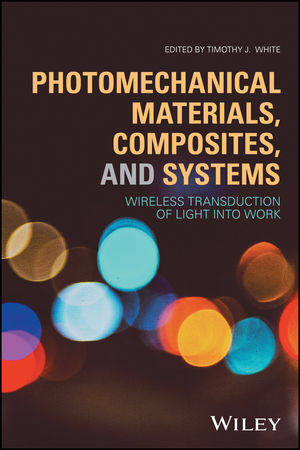
Photomechanical Materials, Composites, and Systems
John Wiley & Sons Inc (Verlag)
9781119123309 (ISBN)
- Titel z.Zt. nicht lieferbar
- Versandkostenfrei
- Auch auf Rechnung
- Artikel merken
An exhaustive review of the history, current state, and future opportunities for harnessing light to accomplish useful work in materials, this book describes the chemistry, physics, and mechanics of light-controlled systems.
• Describes photomechanical materials and mechanisms, along with key applications
• Exceptional collection of leading authors, internationally recognized for their work in this growing area
• Covers the full scope of photomechanical materials: polymers, crystals, ceramics, and nanocomposites
• Deals with an interdisciplinary coupling of mechanics, materials, chemistry, and physics
• Emphasizes application opportunities in creating adaptive surface features, shape memory devices, and actuators; while assessing future prospects for utility in optics and photonics and soft robotics
Timothy J. White, PhD, lives and works in Dayton, OH. Dr. White is a leading researcher in the soft materials community, recently recognized by awards from the MRS, ACS, and SPIE. His research has generally focused on photoinduced effects in materials. Dr. White has published more than 100 peer-reviewed papers.
List of Contributors xi
Preface xv
1 A Historical Overview of Photomechanical Effects in Materials, Composites, and Systems 1
Toru Ube and Tomiki Ikeda
1.1 Introduction 1
References 25
2 Photochromism in the Solid State 37
Oleksandr S. Bushuyev and Christopher J. Barrett
2.1 Molecular Photoswitches in the Solid State 37
2.2 Molecular and Macroscopic Motion of Azobenzene Chromophores 39
2.3 Photomechanical Effects 41
2.4 Solid-State Photochromic Molecular Machines 54
2.5 Surface Mass Transport and Phase Change Effects 62
2.6 Photochromic Reactions in Framework Architectures 65
2.7 Summary and Outlook 68
References 69
3 Photomechanics: Bend, Curl, Topography, and Topology 79
Daniel Corbett, Carl D. Modes, and Mark Warner
3.1 The Photomechanics of Liquid-Crystalline Solids 81
3.2 Photomechanics and Its Mechanisms 82
3.3 A Sketch of Macroscopic Mechanical Response in LC Rubbers and Glasses 92
3.4 Photo- and Heat-Induced Topographical and Topological Changes 97
3.5 Continuous Director Variation, Part 1 97
3.6 Mechanico-Geometric Effects, Part 1 100
3.7 Continuous Director Variation, Part 2 100
3.8 Continuous Director Variation, Part 3 103
3.9 Mechanico-Geometric Effects, Part 2 106
3.10 Director Fields with Discontinuities–Advanced Origami! 107
3.11 Mechanico-Geometric Consequences of Nonisometric Origami 110
3.12 Conclusions 110
References 112
4 Photomechanical Effects in Amorphous and Semicrystalline Polymers 117
Jeong JaeWie
4.1 Introduction 117
4.2 Polymeric Materials 119
4.3 The Amorphous Polymer State 119
4.4 The Semicrystalline Polymer State 121
4.5 Absorption Processes 124
4.6 Photomechanical Effects in Amorphous and Semicrystalline Azobenzene-Functionalized Polymers 126
4.7 Molecular Alignment 132
4.8 Annealing and Aging 138
4.9 Sub-Tg SegmentalMobility 142
4.10 Cross-Link Density 145
4.11 Concluding Remarks 146
References 148
5 Photomechanical Effects in Liquid-Crystalline Polymer Networks and Elastomers 153
Timothy J. White
5.1 Introduction 153
5.2 Optically Responsive Liquid Crystal Polymer Networks 159
5.3 Literature Survey 165
5.4 Outlook and Conclusion 169
References 171
6 Photomechanical Effects in Polymer Nanocomposites 179
Balaji Panchapakesan, Farhad Khosravi, James Loomis, and Eugene M. Terentjev
6.1 Introduction 179
6.2 Photomechanical Actuation in Polymer–Nanotube Composites 180
6.3 Fast Relaxation of Carbon Nanotubes in Polymer Composite Actuators 186
6.4 Highly Oriented Nanotubes for Photomechanical Response and Flexible Energy Conversion 191
6.5 Photomechanical Actuation Based on 2-D Nanomaterial (Graphene)–Polymer Composites 205
6.6 Applications of Photomechanical Actuation in Nanopositioning 213
6.7 Future Outlook 224
Acknowledgments 225
References 225
7 Photomechanical Effects in Photochromic Crystals 233
Lingyan Zhu, Fei Tong, Rabih O. Al-Kaysi, and Christopher J. Bardeen
7.1 Introduction 233
7.2 General Principles for Organic Photomechanical Materials 234
7.3 History and Background 234
7.4 Modes of Mechanical Action 240
7.5 Photomechanical Molecular Crystal Systems 242
7.6 Future Directions 260
7.7 Conclusion 264
Acknowledgments 264
References 264
8 Photomechanical Effects in Piezoelectric Ceramics 275
Kenji Uchino
8.1 Introduction 275
8.2 Photovoltaic Effect 276
8.3 Photostrictive Effect 288
8.4 Photostrictive Device Applications 294
8.5 Concluding Remarks 299
References 300
9 Switching Surface Topographies Based on Liquid Crystal Network Coatings 303
Danqing Liu and Dirk J. Broer
9.1 Introduction 303
9.2 Liquid Crystal Networks 304
9.3 Conclusions 322
References 322
10 Photoinduced Shape Programming 327
Taylor H.Ware
10.1 One-Way Shape Memory 329
10.2 Two-Way Shape Memory 343
10.3 Summary and Outlook 358
References 358
11 Photomechanical Effects to Enable Devices 369
M. Ravi Shankar
11.1 Introduction 369
11.2 Analog Photomechanical Actuators 371
11.3 Discrete-State (Digital) Photomechanical Actuators 373
11.4 Photomechanical Mechanisms and Machines 387
References 388
12 Photomechanical Effects in Materials, Composites, and Systems: Outlook and Future Challenges 393
Timothy J.White
12.1 Introduction 393
12.2 Outlook and Challenges 393
12.3 Conclusion 401
References 401
Index 405
| Erscheinungsdatum | 10.08.2017 |
|---|---|
| Verlagsort | New York |
| Sprache | englisch |
| Maße | 160 x 236 mm |
| Gewicht | 454 g |
| Themenwelt | Naturwissenschaften ► Chemie ► Physikalische Chemie |
| Naturwissenschaften ► Physik / Astronomie | |
| Technik ► Elektrotechnik / Energietechnik | |
| Technik ► Maschinenbau | |
| ISBN-13 | 9781119123309 / 9781119123309 |
| Zustand | Neuware |
| Informationen gemäß Produktsicherheitsverordnung (GPSR) | |
| Haben Sie eine Frage zum Produkt? |
aus dem Bereich


